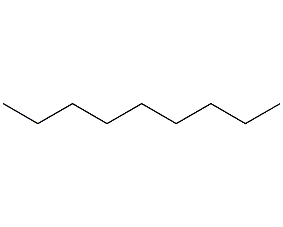
Structural formula
| Business number | 034F |
|---|---|
| Molecular formula | C9H20 |
| Molecular weight | 128.26 |
| label |
nonane, Nonane, Standard |
Numbering system
CAS number:111-84-2
MDL number:MFCD00009574
EINECS number:203-913-4
RTECS number:RA6115000
BRN number:1696917
PubChem number:24886665
Physical property data
1. Properties: colorless and transparent liquid. [1]
2. Melting point (℃): -51[2]
3. Boiling point (℃): 150.8[3]
4. Relative density (water = 1): 0.72[4]
5. Relative vapor Density (air=1): 4.4[5]
6. Saturated vapor pressure (kPa): 0.42 (20℃)[6]
7. Critical temperature (℃): 321[7]
8. Critical pressure (MPa): 2.28[8]
9. Octanol/water partition coefficient: 5.46[9]
10. Flash point (℃): 31 (CC) [10]
11. Ignition temperature (℃): 205[11]
12. Explosion upper limit (%): 2.9 [12]
13. Lower explosion limit (%): 0.8[13]
14. Solubility: insoluble in Water, soluble in ethanol, ether, miscible in benzene, acetone, chloroform. [14]
15. Solubility parameter (J·cm-3)0.5:15.527
16.van der Waals area (cm2·mol-1): 1.369×1010
17. Eccentricity factor: 0.438
18. Critical compression factor: 0.257
19. Critical density (g·cm-3): 0.231
20. Critical volume (cm3·mol-1): 555
21. van der Waals volume (cm 3·mol-1): 98.950
22. Gas phase standard combustion heat (enthalpy) (kJ·mol-1): -6171.65
23. Gas phase standard claimed heat (enthalpy) (kJ·mol-1): -228.24
24. Gas phase standard entropy (J· mol-1·K-1): 506.54
25. Gas phase standard free energy of formation (kJ·mol-1): 25.7
26. Gas phase standard hot melt (J·mol-1·K-1): 210.41
27. Liquid phase standard combustion heat (enthalpy) (kJ·mol-1): -6125.21
28. Liquid phase standard claimed heat (enthalpy) (kJ·mol-1): -274.68
29. Liquid phase standard entropy (J·mol-1·K-1) : 393.6
30. Liquid phase standard free energy of formation (kJ·mol-1): 12.66
31. Liquid phase standard hot melt (J· mol-1·K-1): 284.5
Toxicological data
1. Acute toxicity[15] LC50: 17000mg/m3 (rat inhalation, 4h)
2. Irritation [16] Pig transdermal: 250μl (24h), mild irritation.
3. Subacute and chronic toxicity [17] After inhalation in rats for 65 days (6 hours a day, 5 days a week), the no-effect level was 1.9 g/m3 and 3.2g/m3. Chronic inhalation of nonane vapor can cause neutrophil changes, and pathological examination has not found lung damage.��
Ecological data
1. Ecotoxicity No data yet
2. Biodegradability[18] MITI-I test , initial concentration 100mg/L, sludge concentration 30mg/L, 96% degradation after 4 weeks.
3. Non-biodegradability No data yet
4. Bioaccumulation[19] BCF: 12000 (theoretical)
5. Other harmful effects [20] This substance may be harmful to the environment, special attention should be paid to Pollution of surface water, soil, atmosphere and drinking water, special attention should be paid to fish and water bodies.
Molecular structure data
1. Molar refractive index: 43.74
2. Molar volume (cm3/mol): 177.0
3. Isotonic specific volume (90.2K ): 390.2
4. Surface tension (dyne/cm): 23.5
5. Dielectric constant (F/m): 1.96
6. Polar Chemical rate (10-24cm3): 17.34
Compute chemical data
1. Reference value for hydrophobic parameter calculation (XlogP): None
2. Number of hydrogen bond donors: 0
3. Number of hydrogen bond acceptors: 0
4. Number of rotatable chemical bonds: 6
5. Number of tautomers: none
6. Topological molecule polar surface area 0
7. Number of heavy atoms: 9
8. Surface charge: 0
9. Complexity: 33.3
10. Number of isotope atoms: 0
11. Determine the number of atomic stereocenters: 0
12. Uncertain number of atomic stereocenters: 0
13. Determine the number of chemical bond stereocenters: 0
14. Number of uncertain chemical bond stereocenters: 0
15. Number of covalent bond units: 1
Properties and stability
1. Stability[21] Stable
2. Incompatible substances[22] Strong oxidants, strong acids, strong bases, halogens
3. Polymerization hazards[23] No polymerization
Storage method
Storage Precautions[24] Store in a cool, ventilated warehouse. Keep away from fire and heat sources. The storage temperature should not exceed 37°C and the container should be kept sealed. should be kept away from oxidizer, do not store together. Use explosion-proof lighting and ventilation facilities. It is prohibited to use mechanical equipment and tools that are prone to sparks. The storage area should be equipped with emergency release equipment and suitable containment materials.
Synthesis method
None
Purpose
Used as standard material and solvent for chromatographic analysis and in organic synthesis. [25]

 微信扫一扫打赏
微信扫一扫打赏

